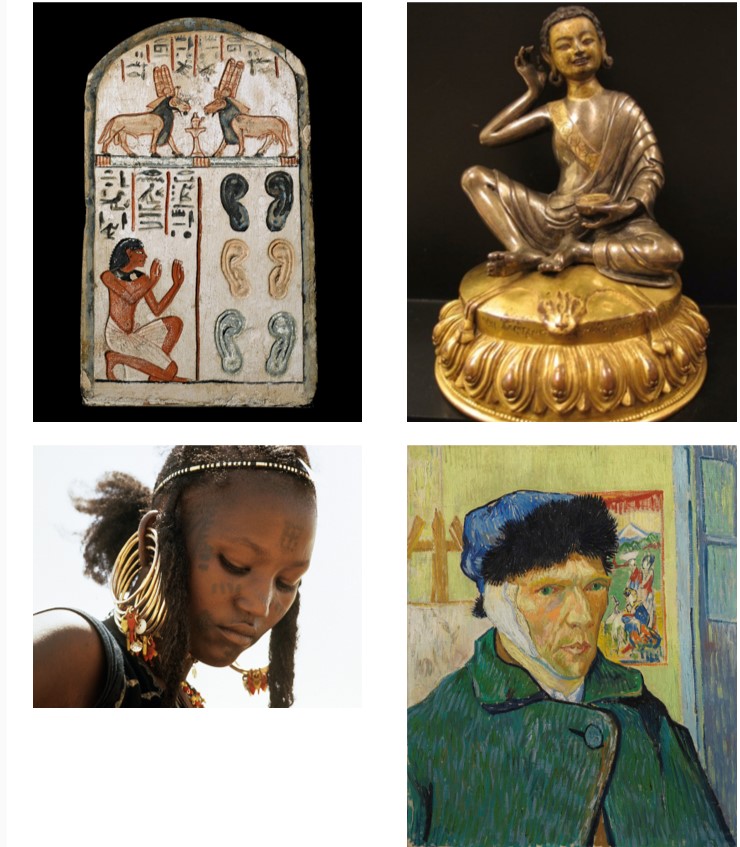A Monthly ARAS Feature
As a sense organ, the ear allows us to communicate, to sense approaching danger and to take in the wonders of music. It is second in importance only to the eye in the history of religious symbolism. Yet in those traditions that emphasize the deity’s capacity to speak, the ear rises to primary significance. On the one hand, the ear receives religious experience: “Yahveh said to Samuel, ‘I am about to do such a thing in Israel as will make the ears of all who hear it ring’” (1 Samuel 3:10-11). On the other hand, it is the human being who speaks while it is God who hears: “Let my prayer come before thee, incline thy ear to my cry!” (RSV, Psalm 88:2).
Hui-neng, the Sixth Patriarch of Chinese Ch’an Buddhism, described his sudden enlightenment this way: “I happened to see another man who was reciting the Diamond Sutra. Upon hearing it my mind became clear and I was awakened” (Platform Sutra, 127). Transmitted to Japan as Zen, the tradition relayed stories of meditators ‘awakening’ to the sound of a temple bell or even to the ‘sound of one hand clapping.’
Hindu cosmology refers to a primordial humming sound—the mantra om—that existed before the creation of light and remains audible to sages through profoundly introverted concentration. Medieval Christians claimed that Christ (as the Word of God) was conceived in his mother’s womb after a dove entered her ear. The more sober Egyptian stele-artisans insisted that only the right ear received the “air of birth”; the “air of death” was received by the left ear, consistent with the widespread notion that the left side is that of the “sinister”—which, for alchemy, nevertheless seemed rich with possibility.
The psychoanalyst Theodor Reik, who once claimed that “the intangible that is invisible as well as untouchable can still be audible”, suggested in his classic text, Listening with the Third Ear, that we truly hear through greater use of our intuition.
The shell-like outer appearance of the human ear has led to some important symbolic expressions. It symbolizes the subtler event of hearing (‘Friends, Romans, countrymen, lend me your ears’-a phrase from Shakespeare’s Julius Caesar, 3.2.79, that just sticks in the ear). The point of the metaphor seems to be that anything worth listening to requires hearing as acute as the ears on our head are obvious. But hearing itself is symbolic. In analysis, one may feel a synchronistic progression through the ear’s own biology -from outer, to middle, to ‘inner ear’ -a structure familiar really only to modern persons. Jung listened attentively to the unconscious speaking through the imagery of his dreams and then responded with concrete behavior to give their meaning reality. That is what is meant by ‘realization of the psyche,’ for which one first must have exceptional ears and the modern equivalent of supernormal hearing.
Our excessively noisy culture-an unavoidable feature of the urban setting-injures our eardrums; yet we are equally subject anywhere to the blaring of collective values that injures our sense of individuality. Gossip from neighbors and the media are filled with the ‘evil spirits’ of shadow projections. If we consciously resist these influences to some degree, then we may symbolically pierce our ears with rings of psychological wholeness.
TOP LEFT – 2An.111 – An Egyptian commoner kneels in prayer before the divine ears of his Lord. They are multiple and open to hear, as are the ‘ears’ of the unconscious if we would ask for its cooperation. Egypt, circa 1295-1070 BCE.
TOP RIGHT – With his classical gesture of a hand-cupped ear, Milarepa, the one-time murderer and later exalted Tibetan yogi (ca. 1052–1135), embodies the Buddhist role of sravaka or “hearer” of enlightening doctrines and songs. Metal, 15th century, Tibet.
BOTTOM LEFT – 8Jf.150 – On the earrings of a West African Woodabe girl are clusters of amulets. They protect her ears from bad influences and evil spirits (ARAS 2:189).
BOTTOM RIGHT – Self-Portrait with Bandaged Ear by Vincent van Gogh. France, 1889.

